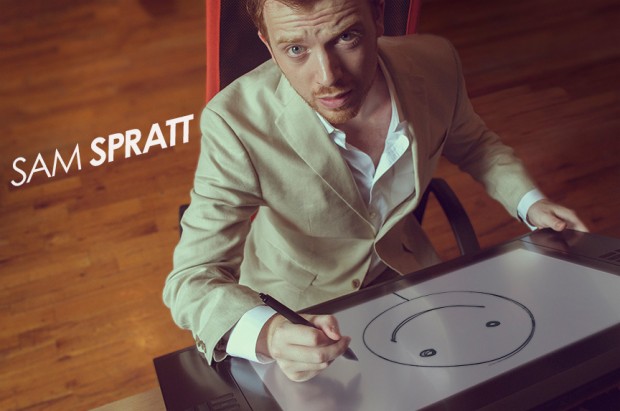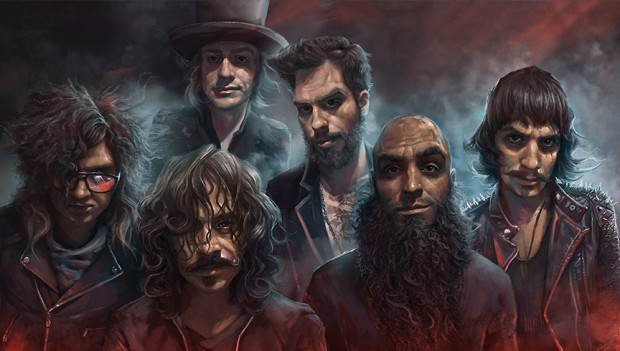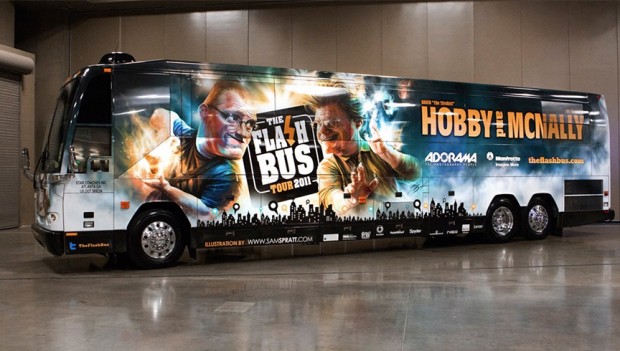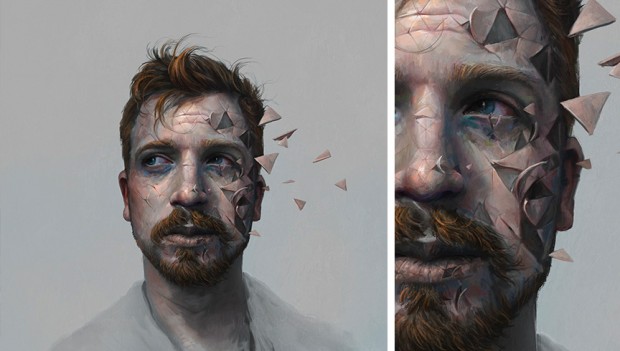An Introduction
Let’s get formalities out of the way because I want to talk about things bigger than me when given a Scott Kelby Soapbox. My name is Sam Spratt and I am a 23 year-old illustrator who focuses on realism. I’ve had the pleasure of making paintings for a mess of major publications, websites, celebrities, corporations, and oddly enough, even a few photographers (the profession which brought about the decline of illustration) such as David Hobby, Joe McNally, Lara Jade, and my good friend, that guy who did the Twilight poster. To watch some examples of how I sketch, render, and paint things, you can follow this link. Obligatory preamble complete. Now let’s move on.
The New Old
I am a knowing hypocrite. I roll my eyes at the Instagram-ification of photography - slapping vintage filters on digital photographs to make them appear old and organic. I loathe the skeuomorphic interfaces in Apple’s user-experience design - digital leather-trimmed calendar apps, paper textured digital notepads, and synthetic camera click sounds trying to make something "classical" which should be as clean and minimal as the aluminum hardware it rests in. Yet… I’m a painter of the digital variety, who has built a career off of translating techniques and concepts learned through Baroque-era oil painting courses into a modern medium. Pixels have replaced pigment for me, but they’re pushed around just the same.
Maybe it’s not as simple as swiping through some preset effects and slapping filters on filters over my every meal with a button press, but the core idea is the same: art and technology are converging into a Kurzweil-esque singularity and we look over our shoulders to build something on top of what came before it.
New mediums don’t always replace the old ones. Anyone who has ever used Photoshop knows that the tools aren’t the manifestations of mere synthetic coding robots, they’re explicitly modeled for usability after old-medium artistic techniques and workflows.
With every new iteration, software simultaneously distances itself from where it came from with new capabilities, as well as shifts the entry-point to older techniques, making them even more accessible. There will be a point in the not too distant future, when cameras pick up anything we can see and anything we don’t — ISO, megapixel, aperture, and shutterspeed will be irrelevant buzzwords. The boom of point-and-shoot, iPhone photography has already made them feel like dusty terminology. Eventually, painting, as outlandish as it may sound, will be dictated by what we think and imagine rather than what we can physically execute. We’re moving more and more towards a world where the ground floor to creating great artwork is being lowered through technology, and every facet of life is manipulated and designed. Even chest hair.
It’s amazing how frightened artists can be of their "fields" converging with technology. People lambasted the latest Final Cut Pro video editing software for "dumbing down pro features," but more so - it was threatening. It enabled mere rookies to access very intuitive and easy-to-use controls and to execute things which would have been incredibly complicated mere years ago. We have hipsters who call themselves "purists" for everything. I am a painter who uses a Wacom stylus. A person who digitally paints with only a mouse looks down on the stylus because it’s "easier." People who do any digital painting are looked down on by digital photographers who are looked down on by manual photographers who are looked down on by traditional painters who are looked down on by writers, who are looked down on by writers with typewriters who are looked down on by writers with pens who are looked down on by writers with feathers and ink, all of whom are looked down on by street artists because everything sucks if it doesn’t have an obvious political message and is plastered over a public wall. All of whom, of course, are looked down on by commercial artists.
It’s not that technology gets rid of previous mediums, it builds upon them, and I think it’s incredibly important that this continues because "art" has just about the loosest definition of any word. We literally live in a world where our own blood and excrement can belong in a museum if it’s wrapped in a sound bite explaining its purported depth and profundity. Without new tools and techniques driving creativity in new generations, we will continue to just point to anything and declare it as high art.
When I paint digitally, I am granted an enormous amount of control. CTRL+Z can wipe away my mistakes, thousands of settings, sliders, rulers, guides, layers, and paths can assist in my ability to manipulate the medium. However, despite the thousands of tools available, I limit myself to only a few, simply because those are the ones that express my techniques and education in traditional painting. The only times I hit "undo" is when I smack my entire face into my keyboard from looking at YouTube comments, everything else I consider to be mistakes worth working over. It builds character (as every dad ever would say). I’m not trying to make my life harder by limiting myself. After all, the difficulty of your medium doesn’t elevate it. But I believe that as art and technology get all up inside one another, it’s important to be wary of the visual gimmick babies which rise up along the way.
3D, HDR, Tilt-shift, multiple-exposure, lens flare⦠these are some buzzwords which mostly pertain to the worlds of photography and video, but they run in parallel with illustration. Many artists look for visual hooks, something that brings individuation or "edge" to their work. It’s marketable, I’ll give it that, but it’s also transient when your style is no more than a fashion trend. In college, I had a teacher who told me something along the lines of: "Sam, design trends, fads, and gimmicks come and go, realism/classicism and the genres bent off of it won’t always be popular, they won’t always sell well, but they have always and likely will always be here to stay." This stuck with me - not just on the illustrative plane, but looking at the photographers I’ve been able to work with, they ride down a similar path, working within the framework of reality. Bending the rules, but not breaking them just to find a "different" gimmick.
I was skeptical about continuing down this road. After all, most painters are taught realism initially and then they push into other styles. "Why would someone hire me to paint their portrait when they could get someone to take a picture that is quicker, more accurate, and possibly less expensive?" I thought. But in the two years I’ve been working, I’ve realized that speed, accuracy, and cost are shockingly relative terms.
Speed
A commissioned portrait typically takes at least 20 hours for me. Far more than it takes for someone to take a photo and edit it. However, I don’t require advanced lighting setups, assistants, hair and make-up, a specific location, expensive equipment, and taking thousands of photos to eventually select just one. A recent client, Donald Glover, had a packed schedule, as most celebrities do — I sidestepped this and met him out on the town. I simply pulled him aside for 5 minutes, and snapped a few reference pictures from different angles in the dim light of the club with an entry-level DSLR. And that was the extent of time I required of him or anyone else — the rest was Whisky. It still took many hours to paint, but the time and resources didn’t come from the client.
Accuracy
I work hard to try to capture a decent likeness. It’s no photograph, but with my limitations in technical ability at this stage in my life, I try to make up for in treatment and character. There’s no tutorial for these things, just practice. Where capturing individual pores and exact anatomy fall short, painting allows flexibility in accuracy. When I get reference, the lighting is irrelevant as the reference is to understand the form. I shoot around the figure rather than from one angle, so that I can learn their anatomy and how light hits it. Learning each person as a three dimensional entity enables client direction like "I’d like my eyes less happy." Vague? Not really. When we smile, every muscle in our face adjusts slightly. Making eyes less happy involves being able to re-paint eye-lids, eye-brows, adjusting forehead crinkles, lowering cheeks, uncurling lips, and dozens of other tiny nuances. If my reference is of someone with their mouth open, and they want it closed, it takes some thinking. But it can be done. The detachment from direct realism, that wiggle-room freed up by color treatment, loose brushstrokes, and texture, lets things like this flow naturally in a painting environment, while in photo manipulation/re-touching, such a thing can easily be botched and unrealistic.
Cost
Much like the relative displacement of time, cost works similarly. I charge more for a single image than most traditional commercial photographers (at my level of exposure) would, but people pay for the imagery and the rights, nothing else. There is no division or expenditures for location, production, sets, equipment, assistants, retouchers, etc. If someone wants the Sahara desert, some velociraptors, and spaceships in the background, painters get to just make those things up. It requires only one person's time and energy, rather than the coordination of entire teams and sets. As you can imagine, the economics of one person over many can be vastly different.
Connection
All of the pros and cons of the aforementioned mediums and technologies meet at the same place with the same question: How do you share them with the world? Well, since you’re reading this, you are probably familiar with The Internet. The Internet is the single most powerful tool available to the public. It wasn’t always that way, but right now, I can get on my computer, in any area of the world with a connection, and I can share my work, my thoughts, news, ideas, and process with anyone who cares to listen. I can put a single image online and track it as it virally trickles and booms across various websites - finding its way into millions of eyeballs.
I don’t believe that anyone with an Internet connection can find success, but I do believe that the barriers which separate someone who wants it and who can have it are largely diminished by the web. Anyone who is willing to treat their craft like they’re a doctor or a lawyer, putting in exhaustive hours like their creative job matters just as much as any other, I believe they can find success. I firmly believe that we live in a time where actual effort met with a basic understanding of social media can sustain us. There are always excuses. Timing, connections, and luck are words people love to throw around for reasons why they haven’t found a footing. With the Web at your finger-tips, those factors are greatly reduced. It’s you, your work, your commitment to improving it, and the power to share it. It’s not an instantaneous process nor one that fits into quick-fix culture, but it’s one where your name can be found and explode through "likes" and "retweets" instead of yearly contests/awards and knowing just the right people.
Closure
We live in a digital renaissance that many disregard because of gossip blogs and cat .gifs. However, technology has allowed generations, new and old, to find ways to create fresh and exciting things from both revolutionary and evolutionary methodologies, and share them in unprecedented ways. Within a single piece of software, I have infinite canvases, brushes, colors, and layers. Nothing has to dry. Nothing has to be coated or prepped. When I pick up my stylus, I waste no time on the monotony of tertiary painting elements — they have been synthesized and streamlined into nearly instantaneous aspects of my work flow allowing me to jump in and create.
There are simple advantages of digital mediums which aren’t up for debate, but within every fiber of the toolset, the tablet, and the software, lies a foundation built by traditional painters, and for that reason, it’s important to not look back at what came before as obsolete. Technology and art are converging — what we can make, and how we make it are expanding at a rapid pace — but old mediums aren’t simply dying.
Why? Because not everything old is broken. I can’t achieve the smell, texture, and true organic nature of oil paint. No amount of slapped-on filters can make a digital photo look like a true tintype. No preset font looks quite like hand-written pen and ink calligraphy. That’s not permanent. Eventually, consumer printers will be able to print the three dimensional depth and texture maps along with a painting. Fully simulated chemicals and physics will enable digital ink to bleed and flow naturally while photos become instantaneously exposed and treated as if in a real dark room. These things aren’t unrealistic, they’re ideas built on readily-available technologies.
Do new mediums carry a stigma? Of course. Very rarely does the digital world find its way into the realms of “high art”, but it is trickling in as digital artists develop new ways to assign pseudo-symbolism to what we do.
Perhaps there’s no grand symbolism to my work to elevate it to the elusive “high art” status, I can’t say there are any deep emotions or bursting geysers of self-expression, and my concepts are typically one-note and surface-level⦠but to say why I make things in this way with this medium for one simple reason:
I’m obsessed with the future and will likely spend my life hurdling towards it, always looking over my shoulder.
You can see more of Sam’s work at SamSpratt.com, keep up with him on his blog, find him on Facebook, and follow him on Twitter.



















How we do it is not as important as why we do it. Art is a circumstance/eventuality of being. Surely no one looks down on the etch-a-sketcher!
You. Are. Insane. Love your work and love this blog post! Well done!!
Awesome article, love it
I first got to know Sam’s work over on Joe McNally’s blog when the Flash Tour with David Hobby was announced. What an artist! Great post!
Fantastic article! Many thanks.
This dude has some serious talent!!
I’ve been a fan since I saw your work on the Flash Bus! I’ve always been fascinated with the Dutch Golden Age of painting for their realism and I have to say, your talent is on par with some of those guys, your work is simply amazing!
Its also refreshing to see someone who focuses more on good technique and creativity than one-click wonders and the latest trends. Great post and thanks for sharing!
Amazing jobs Sam!, I really enjoyed!.
This is the single most inteligent and well reasoned guest post I have seen on Scott’s blog and I’ve been reading them since they began. And to think it was written by a 23 year old is amazing. Most artists twice his age, which is about where I am, have less insight. He also does great work.
 Bernie, I agree with your assessment of the guest post. Sam exudes a wisdom far greater than the average 23-year-old could even think of mustering.
Bernie said exactly what I was going to say, so I’ll talk about a specific point instead.
Sam mentioned something that rarely gets commented on
Sam – “ I loathe the skeuomorphic interfaces in Apple’s user-experience design – digital leather-trimmed calendar apps, paper textured digital notepads, trying to make something “classical†which should be as clean and minimal as the aluminum hardware it rests in. ”
Absolutely – Apple have produced some of the naffest programme interfaces ever, Garage Band being particularly shocking. Similarly I always thought Illustrator’s virtual pasteboard a stupid real world limitation to copy in software. CorelDraw’s implementation of one’s doodling/working area was so much better and flexible.
fantastic guest blog! Â love this feature here and for sure tweeted this out for others to read. Â inspirational and eye opening for artists and non alike
As I was reading and viewing this fantastic post, I was awestruck by both the writing and painting skills of this, this … 23-year old! Way to go, Sam! Thanks @strobist for the tweet link.
Yikes, wow, fantasic work and an amazing guest blog!
Awesome images on this post. Unreal stuff.
Couldn’t comment earlier – was behind a firewall that blocks all social media including Disqus.
I think this is a terrific post, Sam! Your commentary really resonated with me. I first encountered your work with The Flash Bus Tour so kudos to Hobby and McNally for increasing your exposure. I admire the way you have embraced technology in your work. As you hurtle towards the future and that technology morphs and changes I hope you continue to embrace the new and that you ride the wave to explore more notes and dip your stylus below the surface!
This art is just incredible!! I’m nowhere near this experienced, but this is some awesome inspiration right here!!
Great article! This is mandatory reading for my teenagers.
What an artist Sam is!
Amazing effects!